
Henry Augustus Rowland was an American physicist and Johns Hopkins educator. Between 1899 and 1901 he served as the first president of the American Physical Society. He is remembered for the high quality of the diffraction gratings he made and for the work he did with them on the solar spectrum.
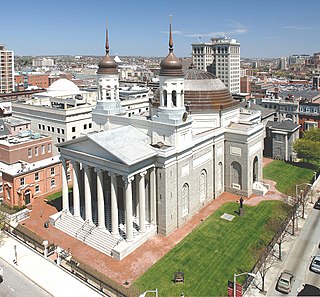
The Basilica of the National Shrine of the Assumption of the Blessed Virgin Mary, also called the Baltimore Basilica, is a Catholic cathedral in Baltimore, Maryland. It was the first Catholic cathedral built in the United States after the nation's founding, and was among the first major religious buildings constructed therein after the adoption of the U.S. Constitution.

Mount Vernon is a neighborhood of Baltimore, Maryland, located immediately north of the city's downtown. It is named for George Washington's Mount Vernon estate in Virginia, as the site of the city's Washington Monument.

Bolton Hill is a neighborhood in Baltimore, Maryland, with 20 blocks of mostly preserved buildings from the late 19th century. It is listed on the National Register of Historic Places, preserved as a Baltimore City Historic District, and included within the boundaries of Baltimore National Heritage Area. The neighborhood is bounded by North Avenue, Mount Royal Avenue, Cathedral Street, Dolphin Street, and Eutaw Place. Bolton Hill is a largely residential neighborhood with three-story row houses with red brick, white marble steps, and high ceilings. There are also larger more ornate originally single-family houses, many houses of worship, parks, monuments, and a few large apartment buildings. Many significant residents have lived in the neighborhood, including F. Scott Fitzgerald, Woodrow Wilson, the Cone sisters, and Florence Rena Sabin.

Union Square is a neighborhood located in the Sowebo area of Baltimore. It dates to the 1830s and includes a historic district of houses and commerce buildings.

The Russell Henry Chittenden House is a historic house at 83 Trumbull Street in New Haven, Connecticut. Built in the 1880s, it was the longtime home of Russell Henry Chittenden, who lived there from 1887 to his death in 1943. Chittenden, known as the "father of American biochemistry", was a professor at Yale University, and the house was declared a National Historic Landmark in 1975 in recognition of his importance.

The Ira Remsen House is a historic house at 214 West Monument Street in Baltimore, Maryland. Built in the 1880s, this nondescript row house was the home of Ira Remsen (1846-1927), a noted chemist and educator who served as president of Johns Hopkins University from 1901 to 1913, and influenced a generation of chemists and chemistry researches with his textbooks and pedagogical methods. This house was listed on the National Register of Historic Places and designated a National Historic Landmark in 1975.

The First Unitarian Church is a historic church and congregation at 12 West Franklin Street in Mount Vernon, Baltimore, Maryland. Dedicated in 1818, it was the first building erected for Unitarians in the United States. The church is a domed cube with a stucco exterior. The church, originally called the "First Independent Church of Baltimore", is the oldest building continuously used by a Unitarian congregation. The name was changed in 1935 to "The First Unitarian Church of Baltimore " following the merger with the former Second Universalist Church at East Lanvale Street and Guilford Avenue in midtown Baltimore. The American Unitarian Association and the Universalist Church of America (established 1866) representing the two strains of Unitarian Universalism beliefs and philosophies merged as a national denomination named the Unitarian Universalist Association in May 1961.

Mount Clare, also known as Mount Clare Mansion and generally known today as the Mount Clare Museum House, is the oldest Colonial-era structure in the City of Baltimore, Maryland, U.S.A. The Georgian style of architecture plantation house exhibits a somewhat altered five-part plan. It was built on a Carroll family plantation beginning in 1763 by barrister Charles Carroll the Barrister, (1723–1783), a descendant of the last Gaelic Lords of Éile in Ireland and a distant relative of the much better-known Charles Carroll of Carrollton, (1737–1832), longest living signer of the Declaration of Independence and the richest man in America in his later years, also the layer of the First Stone of the new Baltimore and Ohio Railroad, just a short distance away in 1828.
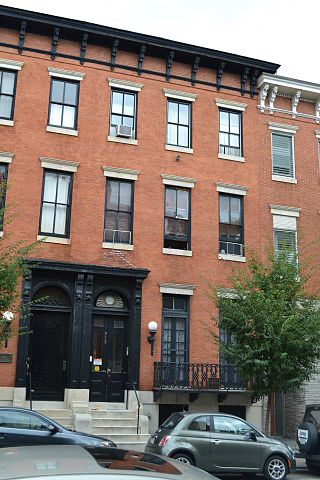
The William H. Welch House is a three-story rowhouse located at 935 St. Paul Street in Baltimore, Maryland. Probably built in the 1880s, it is notable as the residence of William H. Welch (1850-1934) from 1891 to 1908. Welch was one of the "Big Four" founding professors at Johns Hopkins Hospital, and an important conduit of European medical research methods and ideas to the United States. He was also the first dean of the Johns Hopkins University School of Medicine and the first director of the Johns Hopkins School of Hygiene and Public Health. The house was designated a National Historic Landmark in 1976, and is included in the Baltimore National Heritage Area.
The H. L. Mencken House was the home of Baltimore Sun journalist and author Henry Louis Mencken, who lived here from 1883 until his death in 1956. The Italianate brick row house at 1524 Hollins Street in Baltimore was designated a National Historic Landmark in 1985. Mencken wrote of his home: "I have lived in one house in Baltimore for nearly 45 years. It has changed in that time, as I have—but somehow it still remains the same.... It is as much a part of me as my two hands. If I had to leave it I'd be as certainly crippled as if I lost a leg."

St. Mary's Seminary Chapel, located at 600 North Paca Street in the Seton Hill neighborhood of Baltimore, Maryland, is the oldest Neo-Gothic style church in the United States. It was built from 1806 through 1808 by French architect J. Maximilian M. Godefroy for the French Sulpician priests of St. Mary's Seminary. Godefroy claimed that his design was the first Gothic building in America.

Seton Hill Historic District is a historic district in Baltimore, Maryland. It was listed on the National Register of Historic Places in 1975.

The Belvedere is a Beaux Arts style building in Baltimore, Maryland. Designed by the Boston architectural firm of Parker and Thomas and built in 1902–1903, the Belvedere is a Baltimore City Landmark at the southeast corner of North Charles Street, facing north on East Chase Street in the city's fashionable Mount Vernon-Belvedere-Mount Royal neighborhood. In 1991 it was converted into condominiums, though areas remain open to the public.
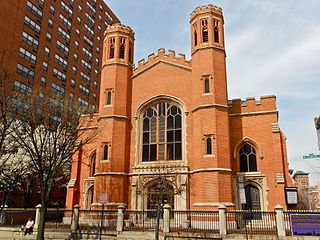
Franklin Street Presbyterian Church and Parsonage is a historic Presbyterian church located at 100 West Franklin Street at Cathedral Street, northwest corner in Baltimore, Maryland, United States. The church is a rectangular Tudor Gothic building dedicated in 1847, with an addition in 1865. The front features two 60 foot flanking octagonal towers are also crenelated and have louvered belfry openings and stained glass Gothic-arched windows. The manse / parsonage at the north end has similar matching walls of brick, heavy Tudor-Gothic window hoods, and battlements atop the roof and was built in 1857.
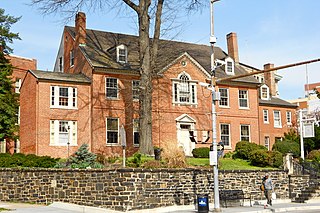
St. Paul's Church Rectory, located a block west of Old St. Paul's Episcopal Church is a historic Episcopal rectory located on steep "Cathedral Hill" at the northeast corner of Cathedral Street and West Saratoga Streets in downtown Baltimore, Maryland, United States. In the rear of the old rectory is a small alley-like extension of West Pleasant Street and to the east behind the North Charles Street former residences and now commercial structures, is another small alley extension of Little Sharp Street.
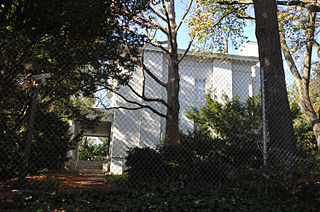
Schwartze Mansion is a historic home located at Baltimore, Maryland, United States in the Irvington Community. It is a two-story, five bay brick Greek Revival building constructed in 1845. It features a flat roofline embellished with a deep modillioned cornice above a frieze decorated with recessed panels. Augustus Jacob Schwartze (1839-1860), a prominent founding investor in Baltimore's important early 19th century textile industry sold land to his brother-in-law, C. Irving Ditty. Augustus and Irving had met while captains of the Maryland Regiment F in the Civil War).

Walters Bath No. 2 is a historic bath house located in southwest Baltimore, Maryland, United States. It is a small brick building of 40 by 70.5 feet laid in Flemish bond with black headers and Maryland limestone trimming. It was constructed in a very simplified form of Renaissance Revival architecture popularized at the turn of the 20th century. The bath house in the 900 block, Washington Boulevard in the southwest area of Pigtown / Washington Village, was built for the City of Baltimore by Henry Walters (1848–1931), who contributed four bath houses to the city. It was co-designed by architect George Archer (1848-1920), and constructed in 1901. Architect Archer was trained at Princeton University and lived in a landmark townhouse of white marble at the southeast corner of North Charles and West Madison Streets, facing Washington Place and the famous Washington Monument. The public bath system was abolished 60 years later, at the end of 1959 with the general extension of indoor plumbing and public water systems in the city's densely packed row houses residential neighborhoods.

Baltimore Heritage is an American nonprofit historic-preservation organization headquartered in Baltimore, Maryland.
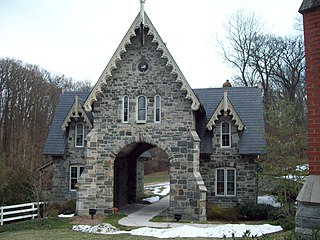
The Sheppard and Enoch Pratt Hospital, known to many simply as Sheppard Pratt, is a psychiatric hospital located in Towson, a northern suburb of Baltimore, Maryland. Founded in 1853, it is one of the oldest private psychiatric hospitals in the nation. Its original buildings, designed by architect Calvert Vaux, and its Gothic gatehouse, built in 1860 to a design by Thomas and James Dixon, were designated a National Historic Landmark in 1971.
























